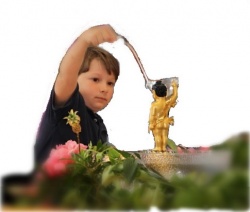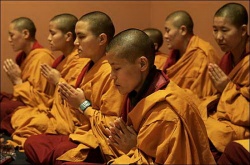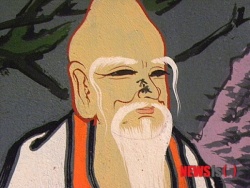Lachen Gongpa Rabsel
Lachen Gongpa Rabsel (bla chen dgongs pa rab gsal) was born in a small town called Gyazhur (rgya zhur) located in Madram (rma 'gram) near the Riwo Tentik (ri bo tan tig) in the district of Hwalung (hwa lung) in Tsonyon region in Amdo. His parents, who belonged to a Bon community, named him Muzuk Selber (mu zugs gsal 'bar). The dates of his life are quite confused in Tibetan historiography; historians have him born in a mouse year, traditionally figured to be 952 and living to the age of eighty-four, to the year 1035. However, this is an error based on the mistaken dating of King Langdarma (glang dar ma), also known as Udumtsen (u'i dum brtsan), and it is more likely that he lived a full century earlier, from 832-915.
Following the assassination of King Langdarma and the collapse of the Tibetan Empire in the ninth century, Buddhist monasteries in Tibet lost royal patronage and were shuttered, and their monks forced back into lay life, no longer exempt from military service. With the loss of its institutions, Buddhism, which not yet been fully integrated into Tibetan society was in a perilous position, the survival of the monastic ordination tradition so critical to the religion's survival in doubt.
According to legend, three monks from a meditation center called Pel Chowori (dpal chub bo ri sgom grwa), Marben Shakya Sengge / Śākyamuni (dmar ban shakya seng ge / shAkya mu ni), Yo Gechung (g.yo dge chung) and Tsang Rabsel (gtsang rab gsal) took a donkey-load of Vinaya and Abhidharma texts and fled, first to Ngari, then to Mongolia, and finally to Amdo, where they found still-active Buddhist centers in the Tsongkha (tsong kha) region.
There they settled at Anchung Namdzong (an chung gnam rdzong) monastery. Many more monks from Tibet also headed to Amdo when their dharma centers were closed, also bringing scriptures with them. However, it is the three monks named above who factor in the legend of Gongpa Rabsel and the triumphant reintroduction of monastic Buddhism to Tibet for which he is given credit in Tibetan legend.
As a young boy Muzuk Salber had received teachings on bodhicitta from a local preacher, Bang / Khang Rinchen Dorje (bang / khang rin chen rdo rje). He later studied additional Buddhist subjects such as Madhyamika and Pramana under Kyi Gyelwai Tsuktor (skyi rgyal ba'i gtsug tor), and received teachings on yoga and other topics from Nam Ganden Jangchup (nam dga' ldan byang chub).
At the age of fifteen he encountered the three (or more) monks from Tibet and requested ordination. He was granted the vows of primary monk (rab byung) followed by novice monk (dge tshul) by Tsang, Yo, and Mar respectively acting as the abbot, acarya, and timekeeper (dus go ba). Muzuk was given the ordained name Gewa Rabsel (dge ba rab gsal) which was later changed to Gongpa Rabsel (dgongs pa rab gsal).
The following year Gewa Rabsel requested full monastic ordination, but his three preceptors could not grant it because they lacked the necessary quorum of five fully ordained monks to perform the ceremony as required by the Vinaya. According to legend they approached Lhalung Pelgyi Dorje (lha lung dpal gyi rdo rje), the monk who had assassinated King Langdharma in c.846 and escaped to [[Longtang (glong thang). He refused to participate, aware that his act of killing was a serious breach of his monastic vows, disqualifying him from participation in the ordination of others. In his place two Chinese monks – known to Tibetan history as Heshang Kawa or Kewang and Heshang Genbak or Gyifen – were recruited to completed the quorum, and thus they granted Gewa Rabsel the vows of full ordination.
Gewa Rabsel then traveled to the Minyak Tangut Kingdom of Xixia where he studied Vinaya with Sengge Drakpa (seng ge grags pa) of Gorong (go rong) who later gave him many important texts of Vinaya and advised him to work hard for the revival of Buddhism. Expressing a desire to go to Tibet, he encountered monks in Longtang (glong thang) in Kham who had left U-Tsang following the collapse of institutional Buddhism there who advised him to remain in the east. Turning back, at Lhatse Bitig (lha rtse bhig tig) he met Ka Wongchok Drakpa (kwa 'ong mchog grags pa) and trained with him for twelve years, studying Abhidharma, Prajñāpāramitā, the Bodhisattvabhumi, and other subjects.
Returning to Tsongkha, to a monastery in Dantik (dan tig), Gewa Rabsel attracted a number of disciples, chief among them Tulpa / Dulpa Drum Yeshe Gyeltsen (thul pa / 'dul pa brum ye shes rgyal mtshan), also known as Drum Shinglagchan (brum shing glag can), a reference to his own Bon heritage, who was ordained by one of Gewa Rabsel's students. Several decades after his death a number of men from U and Tsang who were seeking to restore the Vinaya in Tibet arrived in Dantik. Taking ordination from Yeshe Gyeltsen, they returned to U-Tsang and initiated what became known as the "Eastern Vinaya" tradition of ordination.
According to legend, however, it was Gongpa Rabsel himself ordained the Tibetans, given them all three levels of monastic vows in one day with the assistance of his own preceptors, Mar, Yo, and Tsang, and the Chinese monks, a connection made possible by the misdating of Gongpa Rabsel's life; the ordination of the Tibetans most likely occurred in the 970s and 980s.
According to hagiographies, Lachen Gongpa Rabsel spent the last decades of his life in a cave called Martsang Drak (dmar tsang brag), said to be named for the activity there of two of his preceptors; Yo settled in a place nearby that came to be known as Yo Gelung (g.yo dge lung), later changed to Chi Gelong (dpyid dge lung). He passed away in a wood-pig year, sometimes given as 1035 but more likely to have been one hundred twenty years earlier, or 915. A clay reliquary was made in which his entire body was placed and installed in the cave; later the cave collapsed and his intact body was recovered from the reliquary. His devotees built a small monastery there with his body as the main object of faith. Subsequent legends developed telling of the body speaking and appearing in visions.
Sources
Blo bzang chos kyi nyi ma. 1983. Bla chen dgongs pa rab gsal sogs kyi rnam thar khag gsum; Rare Buddhist Manuscript from the U.S.S.R., vol.2. New Delhi: Tibet House, pp. 1-15.
Davidson, Ronald. 2005. Tibetan Renaissance. New York: Columbia University Press.
Grags pa 'byung gnas and Rgyal ba blo bzang mkhas grub. 1992. Gangs can mkhas grub rim byon ming mdzod. Lanzhou: Kan su'u mi rigs dpe skrun khang, pp. 1147-1149, 1769.
Roerich, George, trans. 1996. The Blue Annals. 2nd ed. Delhi: Motilal Banarsidas, pp. 63 ff.
See also the discussion of Gongpa Rabsel on Sam van Schaik's Ancient Tibet blog (earlytibet.com)
Samten Chhosphel October 2010



